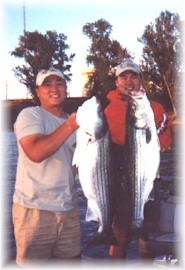|
Spring: Striped Bass
 When
the pear trees along the Sacramento River start to blossom, I know
it is time for the spring Striper run to start. The weather starts
to warm up in the 70ís and the Sacramento River starts to drop to
itís normal level. The river starts to get clearer as each day
passes. The Stripers will start to make their migration to their
spawning grounds. When
the pear trees along the Sacramento River start to blossom, I know
it is time for the spring Striper run to start. The weather starts
to warm up in the 70ís and the Sacramento River starts to drop to
itís normal level. The river starts to get clearer as each day
passes. The Stripers will start to make their migration to their
spawning grounds.
The male Stripers will start up the river system
first. The average size of these males are two
to ten pounds. Large groups of these males will make their way up
the river feeding very heavily. A couple of weeks later, the females
will make their way up the Sacramento river following the males. The
females will range between five to fifteen pounds with some getting
over thirty pounds.
The Stripers will feed on natural live bait such
as shad, crawdads, steelhead trout, splitail minnows, pile worms and
bluegills. They also feed on dead baits such as cut sardines,
anchovies and shad. The Stripers will eat anything they can get
their mouth around.
The best way to catch these Stripers is to anchor
your boat on a sand bar in about ten to twenty feet of water. On the outgoing tide the Stripers
will feed on the top of the sand bars. Sardines and pile worms are
probably the best producers. Filet the sardine and fold it so you
have meat on both sides. Use about a 4/0 octopus hook and a sliding
sinker. Depending on the current, it will
probably take two to four ounces of weight to hold you on the
bottom. A sliding sinker set up will catch you a lot more fish
because the fish wonít feel you on the other end of the line. If
you want to catch a Striper of a life time use a Sacramento Squaw
fish. Use a two hook harness set up and steel leader or thirty pound
test leader. When the Striper takes the bait let it run, it will
stop then take off again. Set the hook as hard as you can and hold
on for the fight of your life.
about ten to twenty feet of water. On the outgoing tide the Stripers
will feed on the top of the sand bars. Sardines and pile worms are
probably the best producers. Filet the sardine and fold it so you
have meat on both sides. Use about a 4/0 octopus hook and a sliding
sinker. Depending on the current, it will
probably take two to four ounces of weight to hold you on the
bottom. A sliding sinker set up will catch you a lot more fish
because the fish wonít feel you on the other end of the line. If
you want to catch a Striper of a life time use a Sacramento Squaw
fish. Use a two hook harness set up and steel leader or thirty pound
test leader. When the Striper takes the bait let it run, it will
stop then take off again. Set the hook as hard as you can and hold
on for the fight of your life.
I recommend a 7ft medium rod with a line rating of
10-20# line. A reel that holds at least two
hundred yards of 20# test line will work fine. When bait fishing I
balance my fishing rod on a beam that goes across the boat. Your rod
tip should be pointing at about eleven oíclock. When the rod
levels out straight set the hook! This will let the Striper run with
the bait without feeling any pressure on the line.
Trolling with Rebels or Bombers also works very
well. Put a plastic worm on the back hook for more action. Trolling
seems to work better when the water clears up. You will also catch
bigger fish trolling.
During the months of April and May, most of the
Stripers will have made their way to their spawning grounds. Colusa
is where most of the Stripers will spawn. The Stripers spawn on top
of the water, a lot of times when you catch a female, the male will
follow her right into your net. This happens quite often when they
are getting ready to spawn.
After the Stripers spawn, they will head back to
the ocean. During the months of June and July the Stripers chase the
anchovies on the beaches. One of the best beach to fish is Pacifica
down south of the Golden Gate bridge. Free lining live anchovies in
five feet of water for Stripers is an experience you have to try.
The whole cycle starts all over again with the
Stripers : August, September and October the Stripers will stay in
the bay. November, December and January the Stripers will move into
the Delta system in huge numbers to feed and get ready to make their
spawning migration.
Good Luck! Remember to keep only what you can eat
and release the rest to catch another day!
|